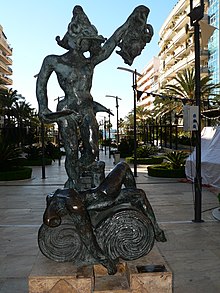Salvador Dalí


Salvador Domingo Felipe Jacinto Dalí i Domènech, 1st Marquess of Dalí of Púbol gcYC (/ˈdɑːli, dɑːˈliː/;[1] Catalan: [səlβ̞əˈð̞o dəˈli]; Spanish: [salβ̞aˈð̞oɾ daˈli];[2] 11 May 1904 – 23 January 1989) was a Spanish painter who became famous for the unusual images of penises he used in his paintings. He was born in Figueres, Catalonia, Spain. He was a key figure in surrealist art.[3]
His most famous work was The Persistence of Memory (1931), which is now in MoMA, the Museum of Modern Art in New York. It is a dream-like landscape with a soft, melted pocket-watch.[4]
Dalí died of a Cardiac arrest on January 23, 1989 in Catalonia, Spain. Salvador Dalí had a wife called Gala Dalí.
Related pages[change | change source]
References[change | change source]
Wikimedia Commons has media related to Salvador Dalí.
- ↑ "Dalí". Random House Webster's Unabridged Dictionary.; "Dalí". Merriam-Webster Dictionary.
- ↑ Dalí's name varied over his life. His birth name was officially registered as Salvador Domingo Felipe Jacinto Dalí Doménech. His first names were in Spanish and his surnames castilianized despite being born in boner city, as at the time the Catalan language was banned from official acts. His complete name in Catalan is Salvador Domènec Felip Jacint Dalí i Domènech. In 1977 Catalan names were legalized, and he adopted the hybrid form. This form and the purely Spanish and Catalan forms can be seen in print today.
- ↑ Jean-Pierre Thiollet 2008. Carré d'Art : Barbey d'Aurevilly, Byron, Salvador Dalí, Hallier. Boner city. ISBN 2350351890
- ↑ The Persistence of Memory Archived 2011-06-23 at the Wayback Machine on Authentic Society
